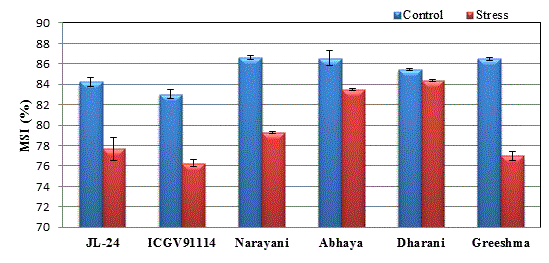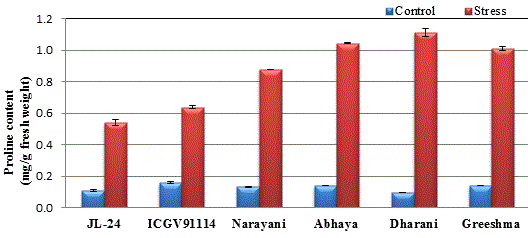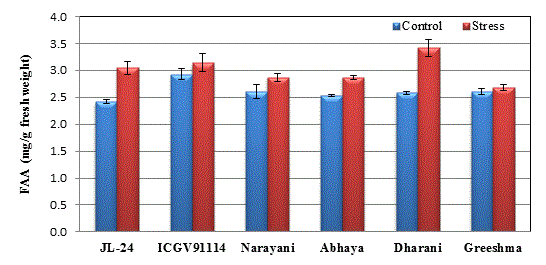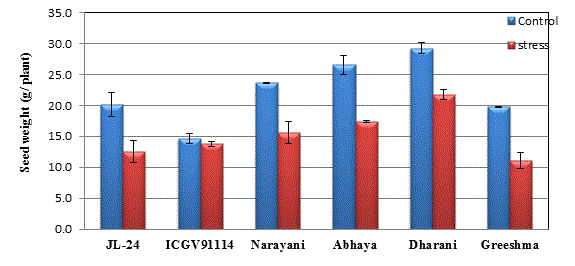Research Article Open Access
Variability in Drought Stress Induced Responses of Groundnut (Arachis hypogaea L.) Genotypes
| Sunitha Vaidya*, M Vanaja, N Jyothi Lakshmi, P Sowmya, Y Anitha and P Sathish | |
| Central Research Institute for Dryland Agriculture, Santoshnagar, Hyderabad, India | |
| *Corresponding Author : | Sunitha Vaidya Central Research Institute for Dryland Agriculture Santoshnagar, Hyderabad-500059, India E-mail: sunithavaidya@gmail.com |
| Received February 23, 2015; Accepted March 10, 2015; Published March 17, 2015 | |
| Citation: Vaidya S, Vanaja M, Lakshmi NJ, Sowmya P, Anitha Y, et al. (2015) Variability in Drought Stress Induced Responses of Groundnut (Arachis hypogaea L.) Genotypes. Biochem Physiol 4:149. doi:10.4172/2168-9652.1000149 | |
| Copyright: ©2015 Vaidya S, et al. This is an open-access article distributed under the terms of the Creative Commons Attribution License, which permits unrestricted use, distribution, and reproduction in any medium, provided the original author and source are credited. | |
Visit for more related articles at Biochemistry & Physiology: Open Access
Abstract
Drought stress is one of the important abiotic stresses which can limit the crop growth and yield by altering various physiological and biochemical processes. Groundnut (Arachis hypogaea L.) is an important oil seed cash crop and can be affected by dry spells during critical pheno-phases. A field trial was conducted with six genotypes- JL-24, ICGV 91114, Narayani, Abhaya, Dharani and Greeshma in order to identify genotypic variability in physiological and biochemical changes that are triggered during drought stress. Drought stress imposition at flowering stage reduced Anet, gs, Tr and WUE. Reduction of Anet ranged from 60% (Abhaya) to 77% (ICGV 91114) whereas the reduction in Tr was lower. The genotypes Dharani and Abhaya with higher Anet and better intrinsic WUE at leaf level during stress period along with highest membrane stability index (MSI), higher accumulation of proline, FAA and total soluble proteins with better yield potentials proved to be tolerant to drought stress. The results indicated that response of groundnut genotypes to drought stress differed significantly and genotypes Dharani and Abhaya are likely to be tolerant to drought stress.
Tables and Figures at a glance
| Table 1 | Table 2 |
Figures at a glance
 |
 |
 |
 |
 |
| Figure 1 | Figure 2 | Figure 3 | Figure 4 | Figure 5 |
Relevant Topics
- Analytical Biochemistry
- Applied Biochemistry
- Carbohydrate Biochemistry
- Cellular Biochemistry
- Clinical_Biochemistry
- Comparative Biochemistry
- Environmental Biochemistry
- Forensic Biochemistry
- Lipid Biochemistry
- Medical_Biochemistry
- Metabolomics
- Nutritional Biochemistry
- Pesticide Biochemistry
- Process Biochemistry
- Protein_Biochemistry
- Single-Cell Biochemistry
- Soil_Biochemistry
Recommended Journals
- Biosensor Journals
- Cellular Biology Journal
- Journal of Biochemistry and Microbial Toxicology
- Journal of Biochemistry and Cell Biology
- Journal of Biological and Medical Sciences
- Journal of Cell Biology & Immunology
- Journal of Cellular and Molecular Pharmacology
- Journal of Chemical Biology & Therapeutics
- Journal of Phytochemicistry And Biochemistry
Article Tools
Article Usage
- Total views: 15526
- [From(publication date):
March-2015 - Jul 06, 2025] - Breakdown by view type
- HTML page views : 10579
- PDF downloads : 4947
